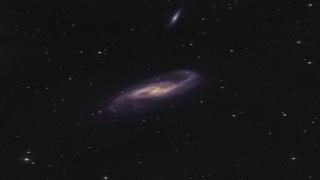Bibcode
Knapen, J. H.; Graham, A. W.; Dullo, B. T.
Referencia bibliográfica
Monthly Notices of the Royal Astronomical Society, Volume 471, Issue 2, p.2321-2333
Fecha de publicación:
10
2017
Número de citas
37
Número de citas referidas
34
Descripción
We report the discovery of an extremely large (Rb ∼2.77
arcsec ≈ 4.2 kpc) core in the brightest cluster galaxy, IC 1101, of
the rich galaxy cluster Abell 2029. Luminous core-Sérsic galaxies
contain depleted cores - with sizes (Rb) typically 20-500 pc
- that are thought to be formed by coalescing black hole binaries. We
fit a (double nucleus) + (spheroid) + (intermediate-scale component) +
(stellar halo) model to the Hubble Space Telescope surface brightness
profile of IC 1101, finding the largest core size measured in any galaxy
to date. This core is an order of magnitude larger than those typically
measured for core-Sérsic galaxies. We find that the spheroid's
V-band absolute magnitude (MV) of -23.8 mag (∼25 per cent
of the total galaxy light, i.e. including the stellar halo) is faint for
the large Rb, such that the observed core is 1.02 dex ≈
3.4σs (rms scatter) larger than that estimated from the
Rb-MV relation. The suspected scouring process has
produced a large stellar mass deficit (Mdef) ∼4.9 ×
1011 M⊙, i.e. a luminosity deficit ≈28 per
cent of the spheroid's luminosity prior to the depletion. Using IC
1101's black hole mass (MBH) estimated from the
MBH-σ, MBH-L and
MBH-M* relations, we measure an excessive and
unrealistically high number of 'dry' major mergers for IC 1101 (i.e. N
≳ 76) as traced by the large Mdef/MBH ratios
of 38-101. The large core, high mass deficit and oversized
Mdef/MBH ratio of IC 1101 suggest that the
depleted core was scoured by overmassive SMBH binaries with a final
coalesced mass MBH ∼ (4-10) × 1010
M⊙, i.e. ∼ (1.7-3.2) × σs
larger than the black hole masses estimated using the spheroid's
σ, L and M*. The large core might be partly due to
oscillatory core passages by a gravitational radiation-recoiled black
hole.
Proyectos relacionados

Las Galaxias Espirales: Evolución y Consecuencias
Nuestro grupo pequeño esta bien conocido y respetado internacionalmente por nuestro trabajo inovativo e importante en varios aspectos de la estructura y la evolución de las galaxias espirales cercanas. Usamos principalmente observaciones en varias longitudes de onda, explotando las sinergías que nos permiten responder a las cuestiones más
Johan Hendrik
Knapen Koelstra